The Menehune: historical accounts of the mythical ‘little people’ of Hawaii
Top image: Painting of a Menehune or the first Hawaiian people from 1933 by D. Howard Hitchcock.
The Menehune: Historical Accounts of the Mythical ‘Little People’ of Hawaii
The mention of the name conjures up images of little people, tiny artisans fervently working through the night to complete their secretive task, before quietly slipping back into the seclusion of the forest before day breaks. This mythical clan of Hawaiian people are known as supernatural stone workers with a long-standing connection to the west side of the island of Kauai, Hawaii.
Historically, Hawaiians believed the Menehune Hawaiian people to be small humans. In fact, there was a clan of people on Kauai and another in the Ka’u area of the Big Island in the early 1800s that Hawaiians identified with an earlier migration. The highly respected R.S. Kuykendall, professor emeritus of history at the University of Hawaii, also concluded the Menehune were humans.
Ethnologist Bruce Cartwright sums the problem up with:
“the lack of any evidence of material culture in the Hawaiian Islands indicating a race of pre-Hawaiians, and the lack of ancient traditions relating to such a race other than references to the Menehune people, has been a puzzle.”
However, in 1951 the Bishop Museum bulletin, “ The Menehune of Polynesia,” described as the only survey about Menehune theories, concluded that the Hawaiian people were not real humans. This bulletin claimed Hawaiian culture was altered under the influence of European contact, and thus stone structures, whose history had been forgotten, were credited to the mythical Menehune.
This implies that Europeans were involved with the creation of the earliest Hawaiian people, and the published myths were of European construction. The bulletin describes the account of the building of the Waimea irrigation canal as a creative European reinterpretation from a bunch of disconnected anecdotes and beliefs that do not constitute history. The Bishop Bulletin finds 1885 to be the earliest mention of the Menehune, with other written references appearing around 1890 to 1900.
The Bishop bulletin describes mythical people of the Pacific, including the Menehune, who share common attributes. They are said to be short with physical features that Polynesians do not identify with. These “guardians of the forest” are said to live in the interior, in caves or primitive tent-shaped huts of sticks covered over with banana, fern, or other leaves, rather than the traditional plaited thatched Polynesian home.
Their sleeping mats and clothing were made from the leaves and fibers of the banana, fern, and ti plants ( Cordyline minalis ). They gathered roots in the forest and bananas were their favorite food. The bulletin indicates they preceded the ancestors of the present native population and, “have almost entirely vanished since Europeans arrived, although a few remain.” And finally, various bands of woodland spirits share similarities with people who represent survivors of early residents.
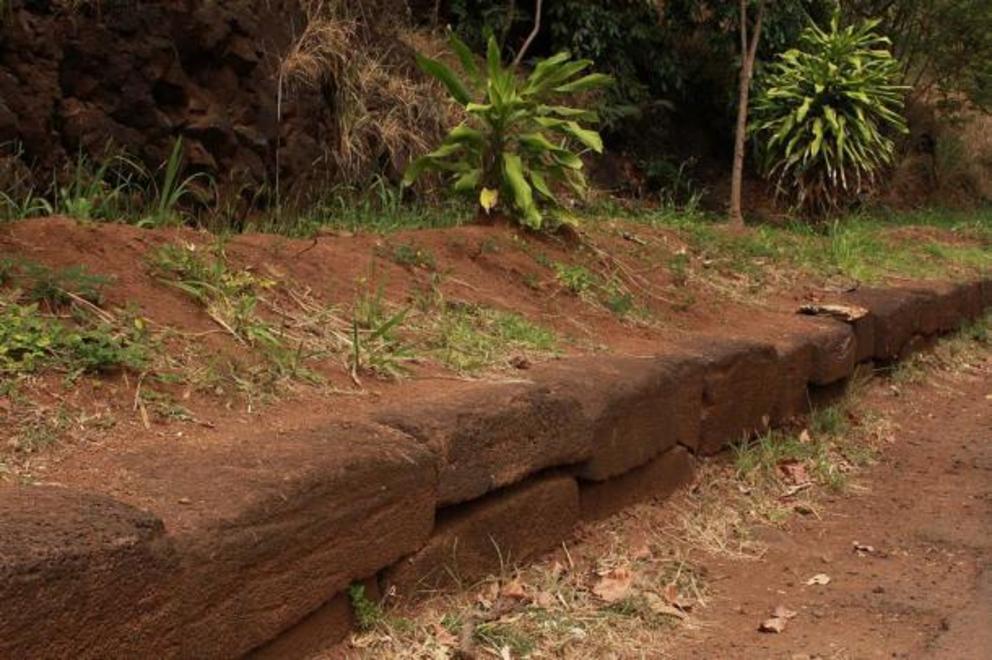 The worked facing stones of Kikiaola purportedly created by the first wave of Hawaiian people prior to 1000 AD, who are now called the Menehune, hence the common name for this irrigation channel being the "Menehune Ditch."
The worked facing stones of Kikiaola purportedly created by the first wave of Hawaiian people prior to 1000 AD, who are now called the Menehune, hence the common name for this irrigation channel being the "Menehune Ditch."
Who Are The Survivors Of The Early Hawaiian People?
In the 1820s missionaries assisted the Hawaiians with committing their language to writing. By 1840 there were two weekly missionary edited newspapers in Honolulu with an extensive circulation. The Hawaiian chiefs of the time were described as men of good education, judgement, and intelligence.
At the same time, the Wilkes expedition noted the native population was vanishing at a drastic rate . . . particularly the chiefs, and that the ancient manners and customs had nearly disappeared.
David Malo and Samuel Kamakau, two of the first native Hawaiian historians, were students at a missionary school who gathered knowledge of the past from the oldest generations and the most informed members of their communities. The first native Hawaiian to publish a historic account was David Malo.
This publication’s timing in 1861 coincided with the birth of the Hawaiian language newspapers, produced entirely by native Hawaiians. It was their first opportunity to publish cultural knowledge. The Menehune Ditch in Waimea was first mentioned on September 26, 1861, in this manner, “in the sprays of Kikiaola, the ditch of the Melehuna [Menehune] will flow…”
The following month, S. K. Kawailiula, a native Hawaiian born in Waimea, Kauai, shared some history about the construction of the Menehune Ditch and the Alokoko Fishpond. But, the source article, written in the Hawaiian language, does not speak of supernatural beings , nor of the magical, superhuman powers that had been “accepted” and distorted for over one-hundred and sixty years.
The early Hawaiian people or the Menehune are described as men who belong to a group of gods different than those of the Hawaiians. The translation of this original document into English identifies the beginning of this misconception, as the English translation immediately transposed them into a “supernatural race of people.” The European account published in 1923 implies the same, stating they were not gods, but merely super strong little humans.
Samuel Kamakau, described by Missionary Cannon as the best Hawaiian orator and one of the smartest natives on the islands, published a newspaper series called Ka Mo’olelo Hawaii in 1869-1870, intended to be a continuation of Malo’s earlier work.
Within the extensive works of Samuel Kamakau lies the answer to the above question. His volume, “ Works of the People of Old, ” details many of the skills and crafts of the ancient Hawaiian people, in many cases the only sources of information on old techniques. As these cultural aspects emerge, the ancient Hawaiians, whose lifestyle Kamakau describes in detail, have characteristics that are similar but more primitive than Polynesian family living , but yet the “same.” As he describes the customs of the earliest generations of Hawaiians, a culture “emerges” that aligns with what we know about the Menehune.
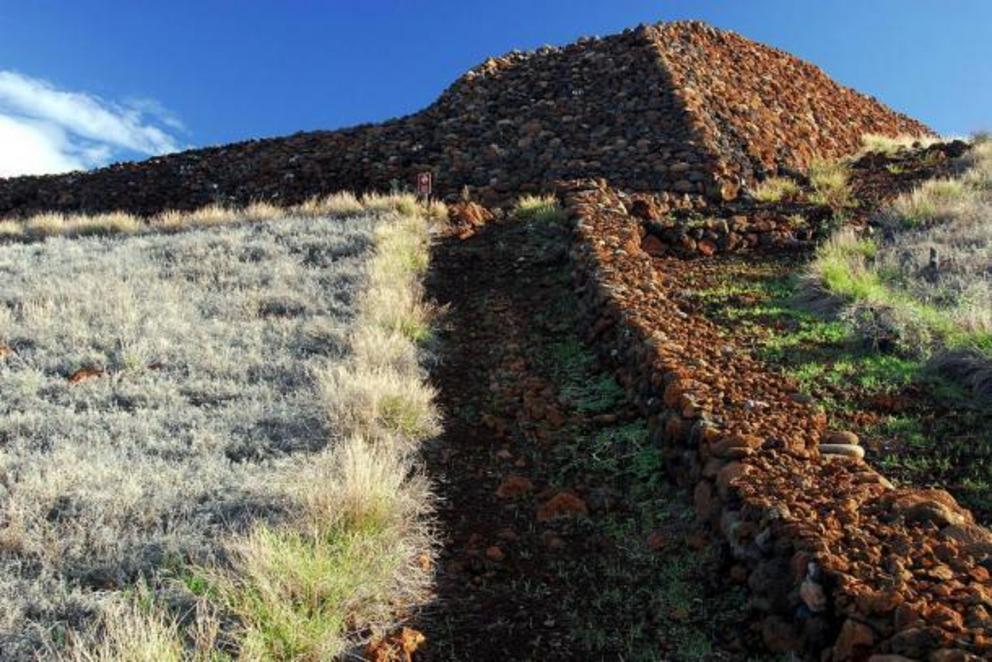 Ruins of the Pu'ukohol? heiau, one of many spiritual sites built by the earliest Hawaiian people.
Ruins of the Pu'ukohol? heiau, one of many spiritual sites built by the earliest Hawaiian people.
Hawaiian People: What We Know Of Menehune Culture
“In ancient times, most of the [Hawaiian] people lived up in the mountains, on the hillsides, and in the valleys…”
Although archaeologists identify terracing, irrigation ditches, and stone outcroppings of ancient villages in the interior, this is not where Hawaiians had villages at the time of contact. In 1779, Captain Cook recorded that all the towns were built along the shore and the plantations were at the back of the community. Up country, there was not a house to be seen.
Kamakau wrote that one of the few forest clans that was known to exist in the early 1800s. But the evidence was only patches of wild bananas , taro, and heaps of stones scattered in the forest. He recalls a time when people lived in caves, cliff shelters, and sheds covered with the leaves of bananas, and other forest growth.
William Brigham, the first director of the Bishop Museum, confirms this tent-shaped primitive hut to be the earliest Hawaiian style, although the knowledge of how to build the more sophisticated Hawaiian grass house and over sixty words used to describe its various components, came with the Hawaiians when they migrated.
There were a few examples of the primitive hut still in use in remote locations after European contact, for instance, Missionary Sheldon Dibble indicates some of the people procured, “poles from the forest and cover them with leaves.”
The Bishop Bulletin mythical clothing description, in which the loin cloths of the Menehune were made of banana fibers is almost identical to recollections of Hawaiian ancestors, who tell us the ancient ones plaited dried banana fibers. The banana leaves hung down on the outside, and the plaiting inside touched the skin, which made a very warm garment. Hunters in the mountains wore such garments because the rain and cold did not penetrate these materials, and these garments were observed until the early 1800s. Kamakau states, “because there were few who knew how to twist the threads and plait them, the making of these kinds of ancient garments was abandoned.”
Before the paper mulberry plant was obtained to make barkcloth, sleeping mats were made from several plants, including the upper part of the banana trunk. The implements for beating tapa barkcloth also changed at that time from a stone anvil to a wooden mallet.
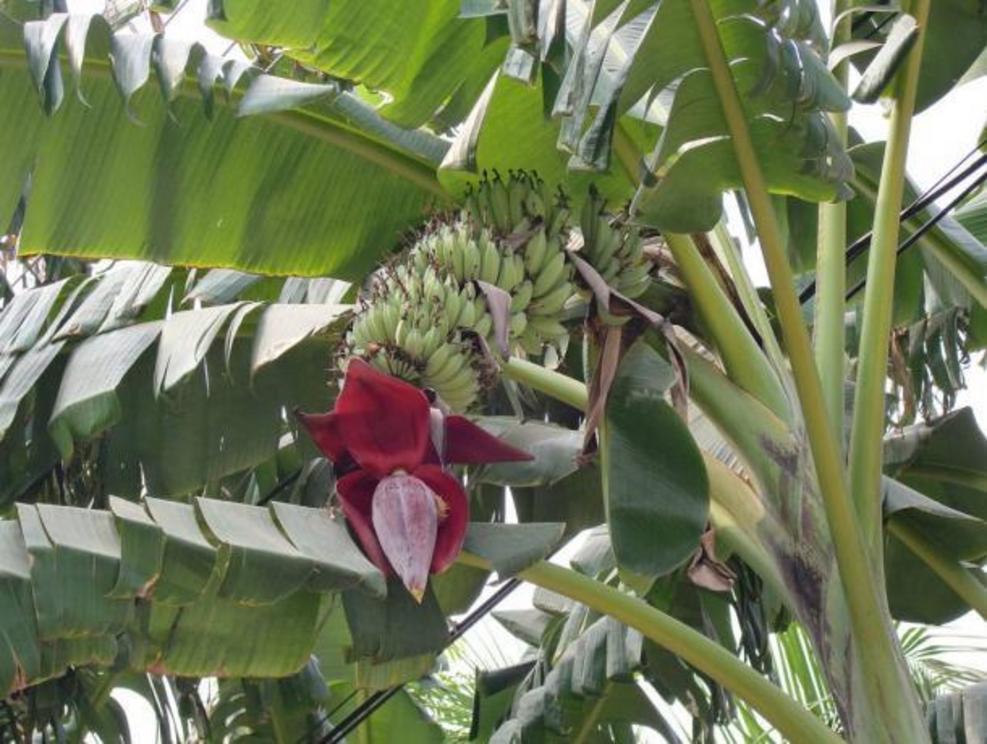 Wild banana trees were a key food and material source for the early Hawaiian people.
Wild banana trees were a key food and material source for the early Hawaiian people.
For The Early Hawaiian People Wild Bananas Were Key
The above accounts reflect the use of the banana for food, clothing, bedding, and shelter for these mountain people. Coincidentally, the history of this fruit is treated differently than the other Hawaiian cultivated plants.
Kamakau indicates this fruit (propagated by live plants, suggesting it was brought to Hawaii with careful preparation) were on the islands before the Hawaiians arrived and were consecrated to the gods. As experienced by Captain Cook when the expedition visited a heiau on Kauai, bananas were the only offerings observed.
This same confusion also play out in how this plant is recalled by botanists. The book, La’au Hawaii, indicates Hawaiians did not cultivate bananas on a large scale, however, the Hawaiian Almanac states there are twenty varieties of bananas recognized as indigenous to the Hawaiian Islands. For comparison, in 1840, the Wilkes expedition identifies twelve varieties of taro, the primary food of the Hawaiians. Cook tells us they observed at least five or six varieties of bananas on Kauai in 1778, which is a much greater selection than any other cultivated plants noted by the expedition.
Further, many of the remote forested inland regions, uninhabited at the time of contact, were covered with wild bananas. Captain Cook on the Big Island tells us, “The woods five to six miles inland abound with wild plantains.” Missionary C.S. Stewart states, “sugar cane and a great variety of the plantains and bananas are indigenous…” Botanist James Macrae, in the valleys above Diamond Head, shares, “in the forest, bananas grow wild to a great size, with many large bunches of fruit. He observes these on Mauna Kea also, “strong, healthy banana trees without cultivation.” And “today for the first time I saw the natives light a fire to roast bananas by rubbing two sticks together…”
Botanist David Douglas, in an area where foreigners rarely go, describes wild banana trees just before the woods terminate on the ascent of Mauna Kea near an old hut of ti leaves, and observes people living in caverns and caves. Hiram Bingham, near the head of the Wainiha River on Kauai tells us, “as in many other mountainous parts of these islands,” wild bananas grew luxuriantly upon the sides of the highlands. Kamakau associates these wild banana patches with mountain villages and the industrious Hawaiian people of old.
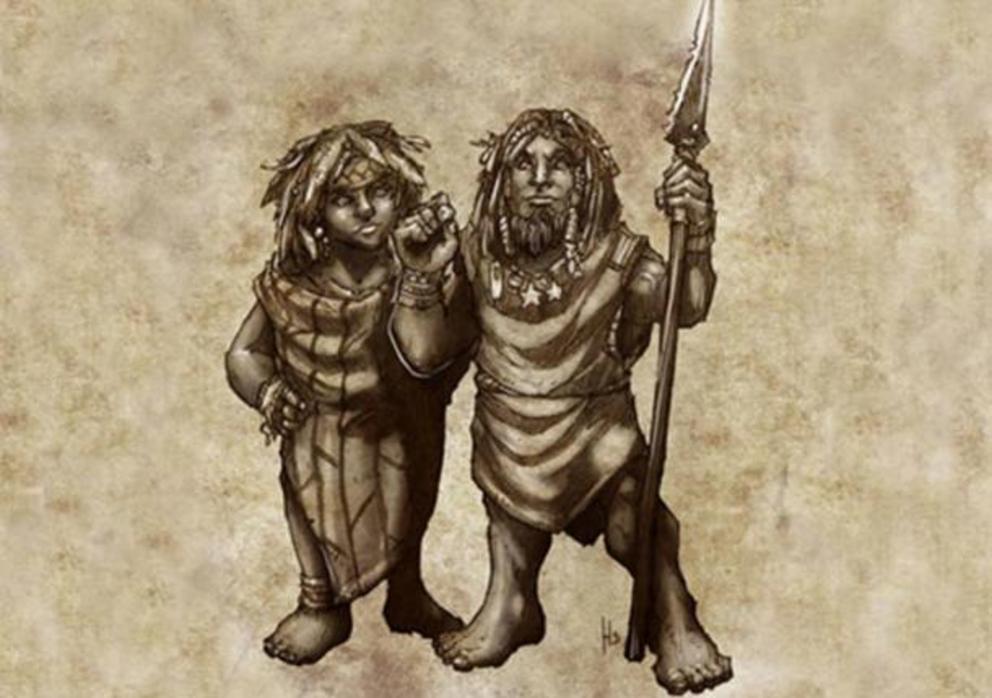 The early Hawaiian people, the Menehune, as depicted in an old drawing, are described as looking a little like this.
The early Hawaiian people, the Menehune, as depicted in an old drawing, are described as looking a little like this.
Physical Descriptions of Ancient Hawaiian Peoples
Scientific Monthly indicates the ancient Hawaiians were one of the most striking native races in the world, tall, well-formed, and muscular, the women very shapely. However, at the time of contact, the Cook expedition observes people in the Ka’u district of the Big Island who were primitive, short, and thin with disproportionate limbs.
Although Kamakau does not provide a physical description of ancient Hawaiians, there are pre-contact Hawaiian burial remains identified by archaeologists ranging from 4 feet 10 inches (1.5 meters) to 5 feet 3 inches (1.6 meters) in height. Missionary Cheever knew a Hawaiian who was short and hairy, short to the point of deformity. Botanist David Douglas describes an adult male who was less than four-feet tall (1.2 meters) with disproportionate limbs.
The Cook expedition describes multiple contacts with a group of people along the east and south part of the Big Island who were short and demonstrated primitive physical features. Missionary Ellis, more than forty-years later, identified what he calls “primitive people” in this same region.
These examples demonstrate that although the Hawaiians are often described as tall, well-formed, and homogenous, first-hand observations and archaeologists indicate they were anywhere from four (1.2 meters) to seven feet (2.1 meters) in height. For comparison, in Tahiti, the Bougainville expedition in 1768 describes members of the lowest social class as averaging 5 feet 3 inches (1.6 meter) to 5 feet 4 inches (1.64 meters) in height.
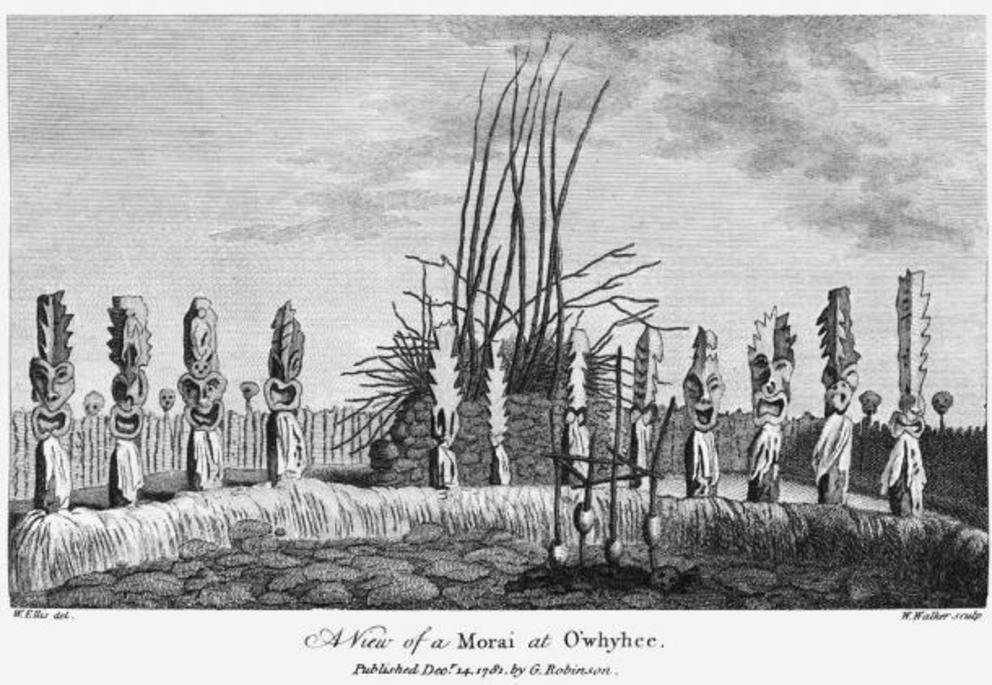 An illustration by William Ellis (from 1781) of the heiau religious site at Kealakekua Bay, Hawaii.
An illustration by William Ellis (from 1781) of the heiau religious site at Kealakekua Bay, Hawaii.
The Primitive Ancient Heiau Temples Of The Early Hawaiians
There was a period of time when the islands became kingdoms ruled by chiefs, which corresponds with the arrival of the kahuna Pa’ao, chiefs, and new religious practices.
Kamakau tells us, when Hawaiians arrived, there was an ancient style of temple already on the islands, stating, “they built heiau…from the seashore to the mountains, where heiau had formerly been built .” We know this to be true because Dr. Emory recognized a primitive inland temple style that does not identify with the Hawaiian culture, yet was observed on all the major Hawaiian Islands, and always featured an uneven number of upright stones.
The fact that the inland temple design at one time existed all over Hawaii was corroborated by A. E. Hudson with the identification of numerous sites in the Haleakala crater area of Maui and on the slopes of Mauna Loa and Mauna Kea on the Big Island.
On a hike in Tahiti, well beyond the contact of civilization, Dr. Emory discovered temples almost identical to the ancient Hawaiian style, including the same simple arrangement of upright stones. Dr. Kirch not only confirms that the earliest Hawaiian temple design is virtually indistinguishable from the simple forms found in Tahiti and the Tuamotus, [identifying this early culture in other Polynesian groups,] but also suggests likeness to those found on the deserted equatorial islands.
Maori anthropologist Sir Peter Buck states the technique of creating similar material things can be carried from one area to another only by human beings. Buck attributes the inland temples to the first settlers. The arrival of Pa’ao led to the change in temple construction wherein the early temples were destroyed, altered, or built over on all the inhabited islands, except for a few in isolated locations which escaped destruction.
There are also over twenty temples and other structures which Kamakau attributes to the Menehune, who he described in 1870 as, “a numerous race of men often spoken of in the traditions of [old.]” Identifying with this, some of the sites Kamakau refers to are listed on the national register of historic places which, after being thoroughly researched, are presently credited to the Menehune.
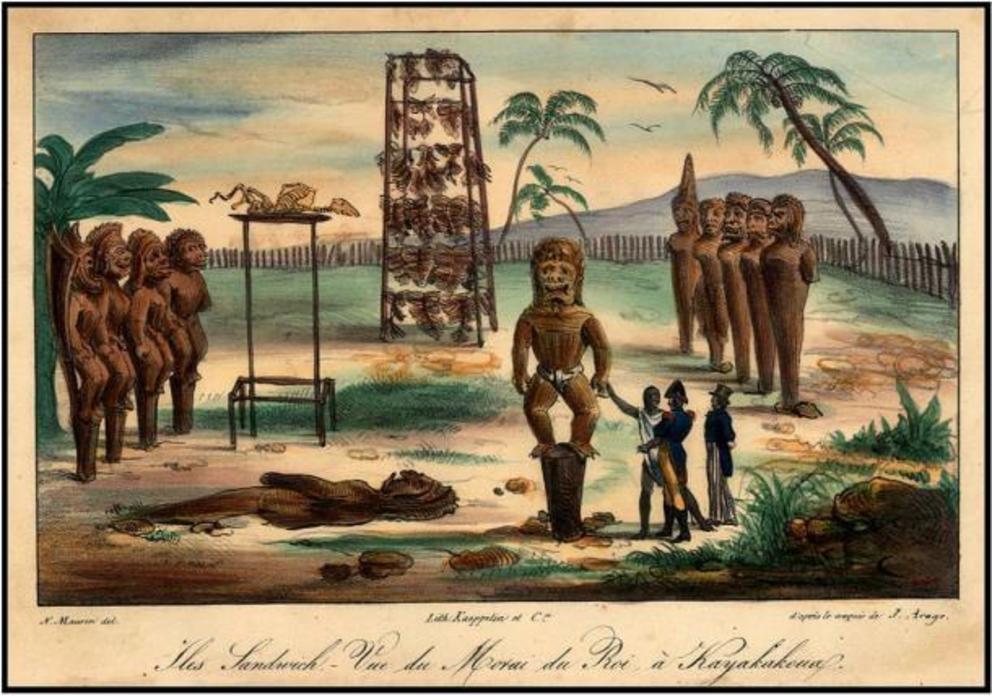 Kealakekua or Kailua-Kona drawn by Jacques Arago and by Maurin. A marvelous image of a ceremonial reception of French Naval Officers in Hawaii, from Jacques Arago's rare account of Freycinet's travels around the world from 1817 to 1820.
Kealakekua or Kailua-Kona drawn by Jacques Arago and by Maurin. A marvelous image of a ceremonial reception of French Naval Officers in Hawaii, from Jacques Arago's rare account of Freycinet's travels around the world from 1817 to 1820.
The Menehune Identified With Primitive Polynesian Religions
Andy Kiersz in, “ Ancient Polynesian Culture Used a Completely Unique Binary Counting System, ” states that all Polynesian cultures had a general decimal system of counting numbers based on powers of ten. This system was observed in the 1700s by Missionary Wilson, who states, “[Polynesians] count in numbers from one to ten…”
The Hawaiian method of counting was different. It was expressed in numbers as multiples of four (times ten,) which were counted as 40, 400, 4,000, 40,000 and 400,000. Missionary Dibble confirms the same method, indicating their computations were all performed in the mind, making use of the fingers of one or both hands. Historian Abraham Fornander identifies the antiquity of this counting system, “the Polynesian language gives undoubted evidence that at one time the people who spoke it did not count beyond four, and that its ideas of higher numbers were expressed by multiples of four.” A similar counting method was also identified on the Cook Islands.
In the 1861 Kauai account, S.K. Kawailiula describes the Menehune in this way, “there was a man named Pi, who belonged to the people of the gods called Melehuna. This is a common word in the Hawaiian number, that is to say 4,000, 40,000 and 400,000 of the gods. All of them are dust.”
The significance of this 1861 account is that it was published twenty-four years before the first date the Menehune are acknowledged in the Bishop Bulletin and recognizes the Menehune for construction of two major stonework projects. It also confirms they are of Hawaiian and not European origin.
This account tells us the Menehune are a group of people who have a different religious belief system. Emory tells us the inland temples are a primitive place of worship that existed prior to the temples of the coastal gods, at a time when each family worshipped its own ancestors. In Tahiti, where the same temple designs were observed, he learned that this religion had once been universal but eventually was followed only by the people of the interior.
This description of people with a different religious belief matches with nearly every early historic account. For example, David Malo associates the clan names with forest spirits and the same grouping of gods, stating the people were divided into farmers, fishermen, house builders, canoe makers, etc. and were [given clan names] of many different appellations according to the trades they followed. The Bishop Bulletin indicates, “all of these [various named] bands of odd little people… apparently belong to the akua (gods,) the innumerable sprits, who the Hawaiians count by the […40,000s, the 400,000s]”
These gods are also summoned when Hawaiians went into the forest to gather wood, the gods of the mountains, to whom the tree belonged, were invoked to secure the charms of the ancestral guardians. These are gods that the Hawaiians associate with woodland spirits, but the Hawaiians do not claim these gods as their own.
European Missionaries including Dibble and Cheever collected information on traditions, such as the history of Wakea, progenitor of the race, who states, let temples be built for Ku, Lono, Kane and Kanaloa (the Hawaiian deities), and also for the 40,000 gods and the 400,000 gods. These examples demonstrate the fact that the ancient people recognized the Menehune gods, and identified these people by this grouping of gods.
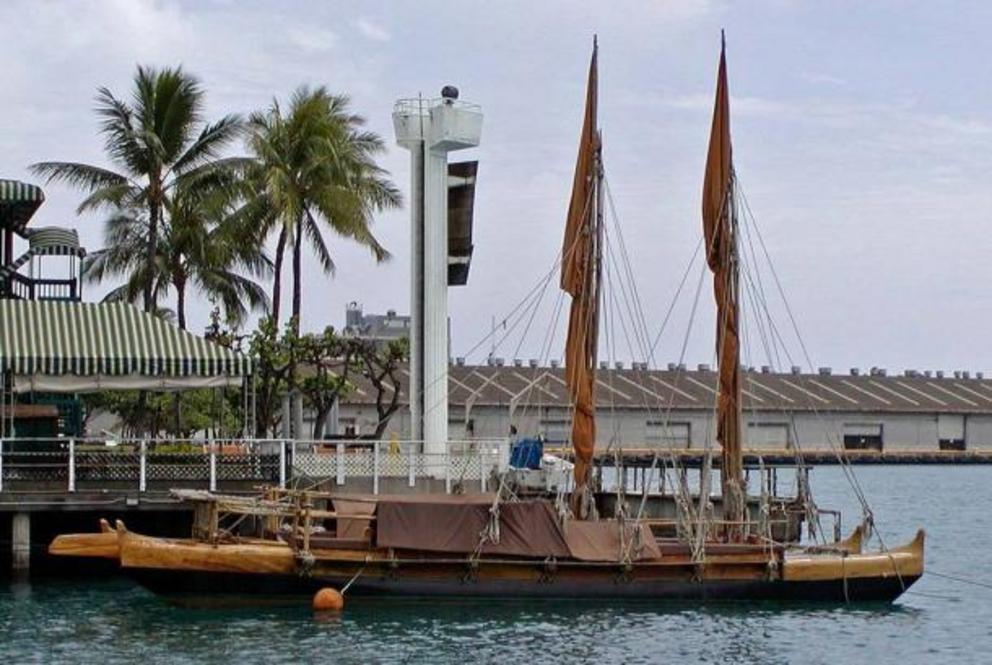 Photo of the Polynesian canoe replica Hawai'iloa, named after an early Hawaiian chief, in Honolulu harbor.
Photo of the Polynesian canoe replica Hawai'iloa, named after an early Hawaiian chief, in Honolulu harbor.
What Happened to the Menehune?
Hawaiian traditions in the story of, “ How Lava came to Hawaii ,” state that the Menehune gradually began to change, grow larger, and eventually merged into the present Hawaiian race.
Missionary Ellis recorded a tradition of Kamapi’ikai, who set sail for Tahiti. After an absence of about fifteen years, he returned with a detailed account of the land he visited. He made three subsequent voyages to this country, however, never returned from the fourth and final voyage. This tradition suggests that in some remote period, Hawaiians may have visited or colonized other islands in the Pacific, and a portion of the population never returned, as the Kauai oral history states.
Ethnologist Bruce Cartwright with the Bishop Museum hypothesizes that a Hawai-iloa boat may have transported the Menehune to Hawaii. He tells us Hawaii was discovered by Hawai-iloa, who left minor chiefs to oversee his workers. These became the Menehune people.
Cartwright’s interpretation concludes that generations later, the Nanaulu arrived on the northwestern islands, establishing their family line on Kauai, Oahu, and Molokai, probably taking the Menehune women as wives.
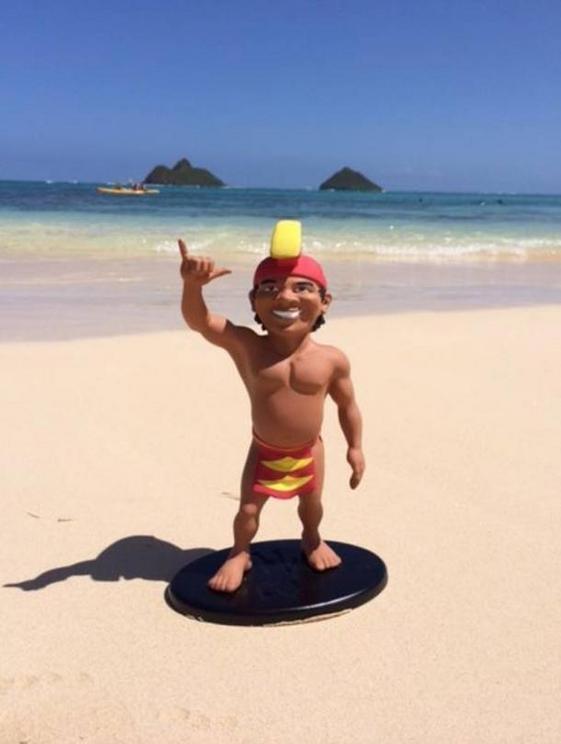 A photo of the menehune statues sold in Hawaii today in memory of the early Hawaiian people, who have been “cuteified” for tourism.
A photo of the menehune statues sold in Hawaii today in memory of the early Hawaiian people, who have been “cuteified” for tourism.
Conclusions
It is hard to understand why Polynesian researchers cling to the misconception that these are mythical people, when so much more can be so easily brought to light, and therefore give these people their proper place in history.
The Bishop bulletin states the only similarities identified between Menehune and Hawaiian customs were in the games they played, but there the resemblance ends. Kamakau’s historic descriptions were published in the Hawaiian language in 1869-70, with an English translation in 1934, but not published in book form until 1978.
The Bishop Bulletin, printed in 1951, utilized the 1934 English version of Kamakau’s work as it relates to fish traps, but later the author relied on a European historian to review these records, stating, “according to Thrum, familiar with [the] yet unpublished records, [Kamakau] does not mention the Menehune except to credit them with having built several heiaus.”
The descriptions of stonework projects published in the Hawaiian language in 1861 prove these projects were attributed to the Menehune long before the European writings, which occurred around the turn of the century. The works of native historians evidence the fact that the Menehune were of Hawaiian origin and there is physical evidence of them such as the inland primitive temple design, the antiquated counting system, the lean-to or tent-shaped hovels, and the frequent stands of uncultivated wild bananas in the mountainous interior.
The material culture of primitive pre-Polynesian people who once existed in Hawaii identifies with that of the Menehune, including how they built their homes, the clothes they wore, the places where they lived, the locations where they built primitive stone temples, what they ate, how they prepared it, and where it was grown, their counting system, and their religion.
This unique culture, identified by Kamakau and evidenced by the observations of early European visitors, represents the Menehune people. The Hawaiian memory of these craftsmen credits them with building canoes and much of the early stonework of the islands, such as roads, temples, fishponds, extensive terracing, and irrigation canals.
Although the material culture is that of a primitive people, in some respects, some of the stonework demonstrates more advanced jointing, cutting, and polishing techniques. These results identify the Menehune’s place in Hawaiian history and opens the door for future studies.
For full references please use source link below.
Video can be accessed at source link below.

